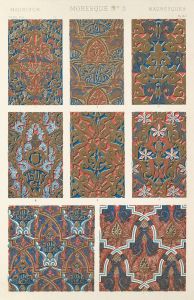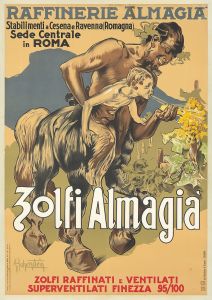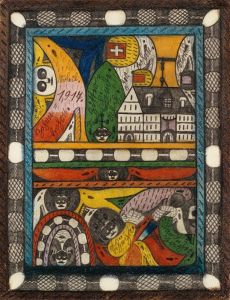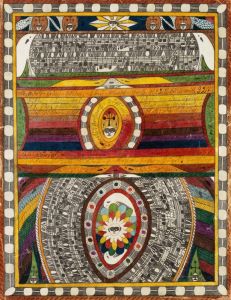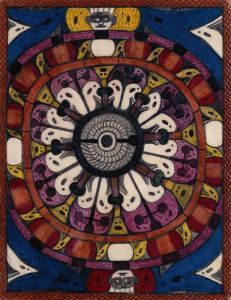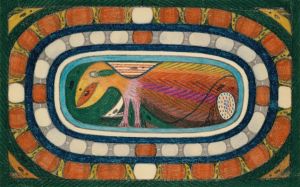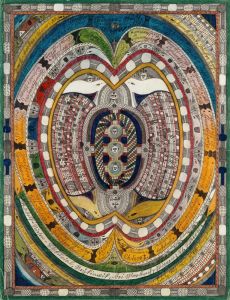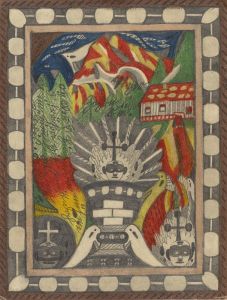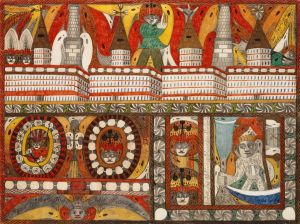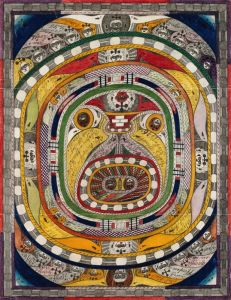
Großgroß=Keiserinn und Groß=Groß=Göttinn Hellveetia, im Haven von Daali; Indien
A hand-painted replica of Adolf Wölfli’s masterpiece Großgroß=Keiserinn und Groß=Groß=Göttinn Hellveetia, im Haven von Daali; Indien, meticulously crafted by professional artists to capture the true essence of the original. Each piece is created with museum-quality canvas and rare mineral pigments, carefully painted by experienced artists with delicate brushstrokes and rich, layered colors to perfectly recreate the texture of the original artwork. Unlike machine-printed reproductions, this hand-painted version brings the painting to life, infused with the artist’s emotions and skill in every stroke. Whether for personal collection or home decoration, it instantly elevates the artistic atmosphere of any space.
Adolf Wölfli (1864-1930) was a Swiss artist known for his intricate and detailed works, often created during his time in a psychiatric hospital. One of his notable pieces is "Großgroß=Keiserinn und Groß=Groß=Göttinn Hellveetia, im Haven von Daali; Indien," which translates to "Great-Great Empress and Great-Great Goddess Helvetia, in the Harbor of Daali; India." This work is part of Wölfli's larger body of art that he produced while institutionalized at the Waldau Clinic in Bern, Switzerland.
Wölfli's art is characterized by its complex, densely packed compositions that often include a mix of text and imagery. His works are typically filled with fantastical elements, intricate patterns, and a unique blend of personal mythology and historical references. "Großgroß=Keiserinn und Groß=Groß=Göttinn Hellveetia, im Haven von Daali; Indien" is no exception, showcasing his distinctive style and imaginative vision.
The piece reflects Wölfli's tendency to create elaborate, fictional narratives. In this work, he combines elements of Swiss national identity, represented by Helvetia, with exotic and fantastical locations such as Daali and India. Helvetia is a national personification of Switzerland, often depicted as a powerful and protective female figure. By elevating her to the status of a great empress and goddess, Wölfli imbues the work with a sense of grandeur and reverence.
Wölfli's use of text in his artworks is significant. He often incorporated autobiographical elements, invented stories, and complex numerical systems into his pieces. The text in "Großgroß=Keiserinn und Groß=Groß=Göttinn Hellveetia, im Haven von Daali; Indien" likely serves to enhance the narrative and provide additional layers of meaning. His writing, much like his visual art, is dense and filled with symbolic references.
The visual elements of the piece are equally intricate. Wölfli's compositions are known for their meticulous detail and repetitive patterns. He often used colored pencils, crayons, and collage techniques to create vibrant and textured surfaces. The imagery in this work likely includes a mix of geometric shapes, organic forms, and symbolic figures, all interwoven to create a cohesive and dynamic composition.
Wölfli's art has been recognized as a significant contribution to the field of outsider art, also known as art brut. His works were largely created in isolation from the mainstream art world, driven by his inner visions and personal experiences. Despite his lack of formal training, Wölfli's art has been celebrated for its originality, complexity, and emotional depth.
"Großgroß=Keiserinn und Groß=Groß=Göttinn Hellveetia, im Haven von Daali; Indien" exemplifies Wölfli's unique artistic vision and his ability to create rich, imaginative worlds through his art. Today, his works are held in high regard and are included in the collections of major museums and galleries, continuing to inspire and intrigue viewers with their enigmatic beauty and intricate detail.





